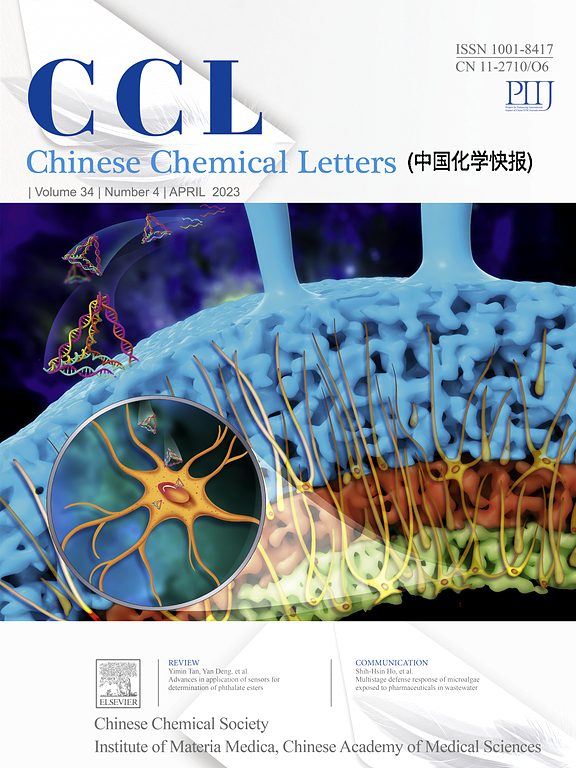分级沸石稳定钴(II)作为丙烷脱氢催化剂:通过碱性后处理提高活性和耐焦性
IF 9.4
1区 化学
Q1 CHEMISTRY, MULTIDISCIPLINARY
引用次数: 0
摘要
过渡金属钴对烷烃具有较强的活化能力,但钴位点的不稳定性导致烧结和积炭,导致快速失活。分级沸石具有不同的孔隙结构和高表面积,可以有效地锚定金属,提高耐焦性。本文采用碱溶液后处理方法合成中微孔沸石载体,并在载体上负载Co作为丙烷脱氢催化剂。结果表明,与有机碱TPAOH相比,无机碱NaOH制备的载体具有更大的介孔体积和更丰富的羟基巢。UV-vis、Raman和XPS分析表明,Co在0.5Co/ SN-1-0.05催化剂中主要以四面体Co2+的形式存在,能有效激活CH键。而0.5Co/S-1催化剂主要含有Co3O4。与纯硅分子筛相比,负载Co2+的分子筛具有更好的丙烷转化率(58.6% %)和丙烯选择性(>96 %)。焦炭表征表明,分级沸石积累更多的焦炭,但它主要是易于去除的无序碳的形式。微孔沸石载体的介孔有助于分散活性Co金属,促进脱氢过程中的焦炭脱除,有效防止烧结失活和焦炭覆盖。本文章由计算机程序翻译,如有差异,请以英文原文为准。

Hierarchical zeolites stabilized cobalt(II) as propane dehydrogenation catalyst: Enhanced activity and coke tolerance via alkaline post-treatment
Transition metal cobalt exhibits strong activation capabilities for alkanes, however, the instability of Co sites leads to sintering and coke deposition, resulting in rapid deactivation. Hierarchical zeolites, with their diverse pore structures and high surface areas, are used to effectively anchor metals and enhance coke tolerance. Herein, a post-treatment method using an alkaline solution was employed to synthesize meso‑microporous zeolite supports, which were subsequently loaded with Co species for propane dehydrogenation catalyst. The results indicate that the application of NaOH, an inorganic base, produces supports with a larger mesopore volume and more abundant hydroxyl nests compared to TPAOH, an organic base. UV–vis, Raman, and XPS analyses reveal that Co in the 0.5Co/SN-1–0.05 catalyst is mainly in the form of tetrahedral Co2+, which effectively activates C![]() H bonds. In contrast, the 0.5Co/S-1 catalyst contains mainly Co3O4 species. Co2+ supported on hierarchical zeolites shows better propane conversion (58.6 %) and propylene selectivity (>96 %) compared to pure silica zeolites. Coke characterization indicates that hierarchical zeolites accumulate more coke, but it is mostly in the form of easily removable disordered carbon. The mesopores in the microporous zeolite support help disperse the active Co metal and facilitate coke removal during dehydrogenation, effectively preventing deactivation from sintering and coke coverage.
H bonds. In contrast, the 0.5Co/S-1 catalyst contains mainly Co3O4 species. Co2+ supported on hierarchical zeolites shows better propane conversion (58.6 %) and propylene selectivity (>96 %) compared to pure silica zeolites. Coke characterization indicates that hierarchical zeolites accumulate more coke, but it is mostly in the form of easily removable disordered carbon. The mesopores in the microporous zeolite support help disperse the active Co metal and facilitate coke removal during dehydrogenation, effectively preventing deactivation from sintering and coke coverage.
求助全文
通过发布文献求助,成功后即可免费获取论文全文。
去求助
来源期刊

Chinese Chemical Letters
化学-化学综合
CiteScore
14.10
自引率
15.40%
发文量
8969
审稿时长
1.6 months
期刊介绍:
Chinese Chemical Letters (CCL) (ISSN 1001-8417) was founded in July 1990. The journal publishes preliminary accounts in the whole field of chemistry, including inorganic chemistry, organic chemistry, analytical chemistry, physical chemistry, polymer chemistry, applied chemistry, etc.Chinese Chemical Letters does not accept articles previously published or scheduled to be published. To verify originality, your article may be checked by the originality detection service CrossCheck.
 求助内容:
求助内容: 应助结果提醒方式:
应助结果提醒方式:


